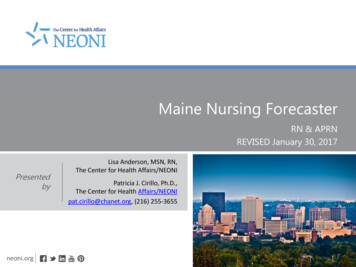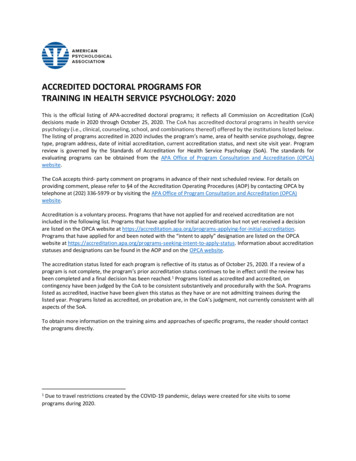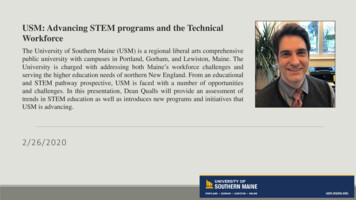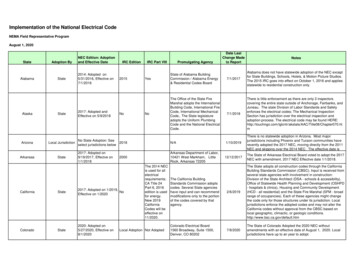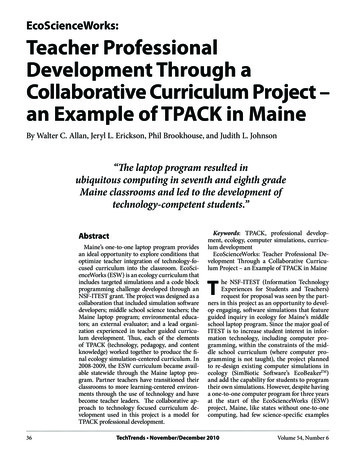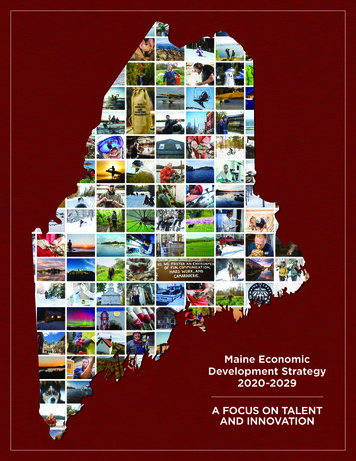
Transcription
Maine EconomicDevelopment Strategy2020-2029A FOCUS ON TALENTAND INNOVATION
November 15, 2019Dear Governor Mills, Members of the Legislature and residents of Maine,This is a 10-year Economic Development Strategy for Maine. It is a dynamic and nonpartisan roadmap designed to foster collaboration among the public, private, nonprofit and education sectors forthe purpose of creating a diverse and sustainable economy. It is the culmination of non-partisancontributions of over 1,300 Maine people; the level of public engagement in this process was overwhelming, and we hope to have captured the ideas and energy within.Maine is at an economic crossroads. We face serious challenges: a likely global downturn as part ofthe normal economic cycle; an aging workforce; and threats to some of our largest industries due totechnology and climate change. This plan isn’t naive about those challenges, but attempts to buildon the opportunities that change presents. Maine has the wind, tides, sunlight, and expertise tolead in developing solutions to the global climate crisis. With innovations that are already underway, we can diversify our heritage industries. We can grow protein in new ways to diversify fishingand farming. We can use wood and wood residuals for new fuels, plastics, and building materials.We can advance health with our biosciences and technologies. The possibilities are limitless. Ourgrowth potential lies at the intersection of global trends and Maine’s assets.Maine also has thriving tourism, hospitality and outdoor recreation sectors that are critical to oureconomy. People who experience Maine come back for more — many as tourists, and some as residents. Showcasing Maine’s beauty is part of our growth strategy.I learned again through this process the special character of Maine people. The other day an entrepreneur said to me, “People want to help; anyone in Maine will at least have a cup of coffee with youand give you their ideas.” This is an example of the connectedness that is part of our Maine fabric, anability to work together toward a common goal, a knowledge that the success of one aids the successof all. This is the commitment and the energy that we will carry forward into implementation.I’d like to thank the thousands who participated in our hearings and online surveys: the 50 membersof our subcommittees; the dozens of staff; the six members of the working team; and particularlyBruce Wagner of the Finance Authority of Maine, who organized and led this planning process. Weall share a common value: there is a place in Maine’s economy for everyone, and we need everyoneto participate to succeed.Thank you,Heather JohnsonCommissioner of the Maine Department of Economic and Community Development
contents420EXECUTIVESUMMARYSTRATEGY AGrow Local Talent725WHY MAINENEEDS A PLANSTRATEGY BAttract New Talent1028VISION GOALS14OPPORTUNITIESSTRATEGY CPromote Innovation30STRATEGY DBuild Connections32STRATEGY EProviding SupportingInfrastructure36STRATEGY FMaintain Stable andPredictable Business Rules38STRATEGY GPromote Hubsof Excellence41APPENDIX AContributors to the Plan
executive summaryIn the following pages, Maine people will find a ten-yeareconomic development strategy for the State of Maine,the first-of-its-kind in more than two decades. It isintended to serve as a dynamic and nonpartisan roadmap that can help foster collaboration among the private,public, education, and non-profit sectors to achieve adiverse and sustainable economy. It is the culminationof the contributions of more than 1,300 Maine people,incorporating a variety of perspectives collected over thecourse of several months.TALENT AND OUR WORKFORCEOut of this report emerge two major necessities to spurgrowth in our economy: talent and innovation. Weknow that Maine has a talented, resilient workforce;there just are not enough of us. Additionally, the skillsneeded to sustain a successful workforce are changing asthe world changes, and that means our workforce must beprepared to evolve with them as well. Further, fosteringeconomic growth will require innovation – and Maineis well-poised, both through its natural resources and itspeople, to embrace innovation that can not only contribute to global climate solutions, but drive productivityacross the entire economy.Undertaking a branding effort in conjunction withLet’s take a deeper look at both.Maine needs to add at least 75,000 people to our workforce over the next ten years. As many know, Maine isone of the oldest states in the nation, and the aging of ourpopulation will result in the loss of an estimated 65,000from our workforce over the next ten years – and that isin addition to the tight labor market the state is currentlyconfronting. There is not one simple solution to this challenge, but many strategies that, when pieced together, canhelp us tackle this issue. This report recommends:the private sector, nonprofits, and the tourism industryto promote Maine as a great place to live, work, and learnin order to attract talented workers.Building bridges for those who are not in the work-force, enabling them to join. Maine has approximately100,000 people who are of working age but are notcurrently in the labor pool. We need to ensure that allpeople, especially those who are underrepresented andyoung people who are disengaged (neither in school norin the workforce), find their role.Welcoming foreign immigrants with programs thatsupport rapid credential acceptance and that supporthousing and transportation needs.—4—
Expanding and simplifying debt relief programs,such as the Educational Opportunity Tax Credit, to helpnew and existing Maine residents retire student debt,thereby enabling them to invest in housing, transportation, and other critical needs.Technology is also significantly changing the skillsneeded across the continuum of the workforce. Automation is changing and will continue to change the waywe work, most likely resulting in fewer but higher-paying jobs. McKinsey and Company has estimated that asmany as a third of American workers will need to switchoccupations by 2023 because of rapid automation. Lookto the check-out area of the local grocery and notice thegrowth of self-checkout services as an example. In thefuture, we will need coders instead of cashiers.For long-term impact, this report recommends:Establishing Maine Career Exploration to helpstudents and families to connect to Maine’s economy.This program will work with students on an age approThat is why the workforce of tomorrow will require priate level to help them explore career opportunities thatcontinuous upgrading of knowledge, skills, and abilities are in line with their individual area of interest. Workto meet ever-changing market needs. And to support force skill development will start at a young age and willthat culture of continuous learning, Maine will also need grow to 100% of Maine students having an internshipan education system that is accessible, affordable, and between their junior year of high school and one-yeareffective. This report estimates that 44 percent of Maine’ post high school graduation.current workforce has some type of credential of value, Better preparing of Maine students with the knowlwhich demonstrates to an employer that the individual edge, skills and abilities that are aligned to the growth ofhas mastered a skill of use in the marketplace. By 2025, the digital economy.this report predicts that Maine’s economy will need 60to 65 percent of its workers to have credentials. So not Investing in educator preparation and professionalonly does Maine need more people in the workforce, but development to improve outcomes in pre-K through 12education in Maine.Maine needs more people with credentials.As detailed in the pages ahead, this report recommends DRIVING INNOVATIONpursuing aggressive strategies to meet both demands. In It is a time-tested concept: innovation drives economicgrowth. According to the U.S. Chamber of Commerce,the near-term, Maine should:economists have calculated that 50 percent of the counDevelop a system of stackable, micro-credentials try’s GDP growth is attributed to increases in innovation.that enable students to quickly and affordably obtain Yet, while pockets of innovation are occurring througha credential of value, which can be used to build toward out Maine, such as the Maine Aqua Ventus project toother credentials and be transferred fluidly among Maine create the first floating offshore wind platform, or theeducational institutions.wellspring of microbreweries across the state, Maine lacksIncrease the availability of online learning and other a clear and supported culture of innovation.flexible programs that are relevant to Maine employers With that said, Maine’s strengths position us well to innoand workers.vate, and opportunities for innovation abound in everyInstitute statewide programs through higher educa- industry. The time is right for Maine businesses of alltion institutions that provide co-op experiences, intern- sizes and sectors to partner with education institutions,ships, research experiences, and apprenticeships for all nonprofits, and governments to drive that culture ofinnovation and, ultimately, deliver solutions that will notMaine students.only power our economy, but the world economy as well.—5—
This report recommends:Supporting the continued growth of bio-basedEmbracing the opportunity to capitalize on the alternative products that emerge from the intersectiongrowth of clean, renewable energy sources, includingsolar, wind, and biofuels. Our state has the wind, water,and solar exposure to generate substantial clean andrenewable energy for both Maine residents and businesses, and, with our vast natural resources and worldclass educational institutions, the ability to innovate inthese fields.of wood supply, bioplastic, and advanced building material technologies.Investing in research and development. The State canhelp with academic research support, and with risk-enhanced financing from existing entities such as the MaineVenture Fund, Maine Technology Institute, and theFinance Authority of Maine to support innovation inPursuing opportunities for sustainable fishing, such the private and nonprofit sectors.as aquaculture, to complement traditional fishing andIn the coming pages Maine people will find a specific setmeet the growing demand for a traceable food supplyof strategies and action steps designed to induce collabothat is changing the way we fish and farm. Maine shouldration across sectors to attract talent and inspire innovaalso pursue the growth of support services, such as fintion. As our workforce ages and global trends create newfish vaccines, testing for exports, and veterinary supportchallenges and opportunities, now is the time to taketo grow ancillary economies.action together.HERE IS WHAT WE KNOW:there is a spot foreveryone in Maine’seconomy and weneed everyone toparticipate.—6—
why maine needs a planThe global economy has cyclical elements, and aneconomic downturn is likely within the 10-year windowof this plan. This is a shared risk for all states. In addition,Maine has some unique challenges.What are the consequences? Economists Michael LeVertand Catherine Reilly modeled the consequences of noin-migration for the Greater Portland region in 2034.2They projected that in the absence of outside in-migration, the labor force would drop by 10% — and as a conseThe first challenge is that Maine is among the least diverse quence, so would income, employment, and tax revenues.and oldest states in the nation. More people are expected The same is true for the state as a whole.to retire than to enter the labor force in the comingdecade. In the absence of greater in-migration to the A second long-term challenge is that Maine’s jobs do notstate, Maine’s labor force faces a challenge of long-term pay enough. In the last twenty years, the average annualdecline. 1earnings in Maine’s private sector fell from 83% of theMaine Labor Force Projection to 2016CIVILIAN LABOR FORCE750,000650,000Baby Boomers Exiting 01930s Depression &World War II Birth 921997200220072012201720222026250,000 “Workforce Trends & Outlook in Maine: Presented to the Innovation, Development, Economic Advancement & Business Committee,”Glen Mills, Maine Department of Labor, 2019.2Greater Portland Tomorrow: Choices for Sustained Prosperity, September 2017, Barringer et al, Appendix A.184%83%—7—
national average to 78%.3 The relative decline can beexplained, in part, by the reduction in the number ofmanufacturing jobs in Maine. But regardless of theexplanation, the problem remains. We can’t have a quality of life for a our residents, attract people to move toMaine to work, or meet our public policy goals unlesswe increase wages and salaries to something closer to thenational average.tal investment and entrepreneurship; and by increasingthe skills and education of the workforce. The elementsof the challenge are interrelated, therefore the solutionmust be comprehensive and systematic.Since 2008, Maine’s Gross Domestic Product (GDP) hasgrown dramatically slower than the rest of the UnitedStates. From 2008-2018 the compound annual growthrate for Maine is .6% versus the growth rate of the UnitedOur low wage rates are related to the lower-than-aver- States at 1.8%. (https://www.bea.gov/data/gdp/gross-doage value of the products and services that we produce. mestic-product).The average job in Maine produces about 88,000in “net” sales . The economic term for this is “value- The global economy is changing and requiring innovaadded.” Nationally, the average is 120,000. One way tion and new workforce skills. Maine needs to chart ato increase value is to develop new products. This can be course that addresses these challenges and creates oppordone through research and development conducted by tunities based on them. Our economy can’t stay the same;public, private, and nonprofit agencies; by increasing capi- doing nothing will result in dramatic economic, wageand job loss.Maine Average Annual Earnings as a % of NationPRIVATE 20072009201120132015201776%34QWI Explorer Application, U.S. Census BureauIn 2012 dollars. Net sales equal total sales less the cost of other product inputs.—8—Maine Average AnnualEarnings as a % of NationPRIVATE SECTOR
Economic development at its best is collaborativeand looks at leveraging assets of the public, privateand non-profit sectors. Effective coordinationof efforts is key to success. This plan can offer aroadmap to statewide execution.
vision goalsMaine has all of the needed natural ingredients to growand prosper over the next ten years and beyond. In aworld that is seeking renewable resources to replacepetroleum-based products, Maine has an abundanceof forests, and the technology to convert them intoenvironmentally responsible alternatives. As theworld demands ever-greater sources of protein, Mainehas its extensive coastline and abundant resourcesfrom the sea. As climate change alters global tradepatterns, Maine has well positioned deep-water ports.As much of the world seeks to escape over-crowdedand increasingly unsafe cities, Maine offers accessible, safe and livable communities. That is why we putforward our vision with confidence.— 10 —
OUR 10 YEAR VISIONBy 2030, Maine will be an international leader with avibrant, sustainable, environmentally-responsible economy.All across the state, the people of Maine will have access toan unmatched quality of life and good-paying jobs.OUR 10 YEAR STRATEGIC GOALSTO ACHIEVE OUR VISION,WE HAVE ESTABLISHED THREE GOALS.grow the averageannual wage byincrease the valueof what we sellper worker by 10%5 10%6to the benefit of workers atall income levelsAttract75,000people to Maine’s talent poolboth by increasing participation among Maine’s existingpopulation, and attracting new people from out of state —thus turning a potential labor force shrinkage into a gain.56From 45,370 to 49,900, in inflation-adjusted dollarsFrom 87,160 to 95,876, in inflation adjusted dollars
There’s a place for everyone in Maine’s new economy:people who like to work with their hands and peoplewho like to work with data; people who work in thewoods and people who work in offices; new arrivalsand old-timers. Maine is a place where people willingto work hard can find satisfying and rewarding careers.
The problems are interconnected, so the solutions we propose areinterconnected as well.The solution startswith talent.
opportunitiesEconomies are dynamic. From 2017 to 2018, there wasa net gain of 5,600 jobs in Maine — less than 1%. Butthis number does not tell the whole story. During thatyear, Maine employers lost 29,000 jobs and created32,000 new ones. Around 100,000 people were hired,and 96,000 left their jobs. In other words, one in sixemployees was on the move.Many of the new jobs that will be created in the nextten years don’t exist today. And, of the existing jobs thatwill remain, many will be transformed by technology.The challenge is to identify which combination of globaltrends and Maine strengths will offer the creative spacefor the high-paying jobs of the future to be realized.Dr. Andrew Crawley of the University of Maine, andAngela Hallowell from the Maine Department ofAdministrative and Financial Services, took on thechallenge of doing an analysis. They identified four“thematic areas” in which Maine has current strengths,there is growing global demand, and there is a potential for job creation — particularly at the intersectionsof these strengths. The four themes are: Food/Marine,Forest Products, Technical Services, and Making/Manufacturing.7CRAWLEY AND HALLOWELL WRITE:7For example, in the last couple of years theforest product industry has seen quantumleaps forward in development where newproducts have begun to emerge such asnanocellulose. This product takes advantage of the great abundance of trees withcutting edge science and engineering.To keep pushing this evolution, supportis needed in the existing value chain, i.e.loggers are still required to fell trees andtransport is still required to mills, in addition to new elements such as coders, chemists and biologists. This thematic approachrequires cross cutting labor force policiesthat generate the depth of skills and training needed from basic to advanced degrees.Crawley and Hallowell, “Developing Industrial Thematics for Maine Technical Report,” 2019— 14 —
bio-basedalternativesForest products is an example ofMaine’s key position in developingsolutions to meet global demand.Innovative building materialsthat sequester carbon and makebuildings more energy efficientleverage Maine’s forest resourcesand forest-based economy torespond to consumer demand formore sustainable products.MAKINGMANUFACTURINGAdvanced — 15 —
climate changeA similar intersection of themescan be found in climate change.The global trend of looking towardgreen energy sources intersectswith the strength of the Maineeconomy in technical servicesand making/manufacturing, andcreates openings for new technologies, industries, and jobs.TECHNICALSERVICESOn and OffshoreWind PowerTidal powerBattery DevelopmentSolar DevelopmentMAKINGMANUFACTURINGMaine is well positioned to develop solutions forthe global climate challenge. We have establishedambitious goals to reduce our carbon emissions,including requirements for increased renewableenergy generation. While a changing climate andsea level rise offers enormous challenges for oureconomy, there is also opportunity to create solutions that will position Maine as an economicleader in innovative technologies. Renewableenergy, energy efficiency and safe and traceablefood production will create business opportunitiesand good jobs in some of our heritage industries,while also supporting energy and climate goals.As of November 2019, Maine has approximately200 solar projects in the permitting process.According to a recent report,8 energy efficiency isthe fastest-growing energy industry in the countryand there are more than 8,600 energy efficiencyjobs in Maine.9 As Maine grows investment inenergy efficiency through measures like weatherization and installation of heat pumps, thestate will save ratepayers money and create newjobs. Graduates of programs such as the Kennebec County Community College Energy Servicesand Technology Program can enter the workforcewith skills in the installation and design of high-efficiency and renewable plumbing, heating, ventilating, and air conditioning systems.Maine has one of the best offshore wind resourcesin the country, and offshore wind can not onlyprovide clean power to New England, but can bea major economic driver for Maine. One exampleof innovative research and economic developmentis the Maine Aqua Ventus Project, a pilot projectthat is poised to launch the first floating offshorewind turbine in the United States. The floatingconcrete semi-submersible hull was designed atthe University of Maine and the Advanced Structures & Composites Center, and the project hasdeveloped a partnership with construction andconstruction services company Cianbro. Based ona University of Maine economic study, the full lifeof the pilot project would produce an estimated160,000 jobs including planning, construction,89e 19/e 2.org/wp-content/uploads/2019/09/MAINE 2019 Final.pdf
growing demand for safe, climate responsible food sourceTECHNICALSERVICESFOOD SYSTEMS ANDMARINE RESOURCESMAKINGMANUFACTURINGFinfish veterinary servicesShellfish vaccinesTesting for exportsSustainable aquacultureinnovations— 17 —
and ongoing operations and maintenance, and wouldgenerate around 200 million in economic impact. Arecent study showed that the offshore wind industryrepresents a nearly 70 billion revenue opportunity inthe next decade . The majority of the research is complete— now the focus shifts to project development, good jobsand energy savings.growth areas. This is a trend that can support Mainegrowth. AI is a field that will allow for more remote workand for businesses to thrive in smaller markets. This willbe an advantage in Maine because of our dispersed population. Additionally, Maine is well positioned to housethe growing demand for data centers with direct accessto Europe and the US, available land and a cool climate.Maine also leads New England in onshore wind powergeneration. Northern Maine Community College offersa Wind Power Technology program that is preparingfuture wind technicians with a focus on wind turbinemaintenance and electrical power production.Maine has a strong base economy that we need tocontinue to grow. It is critical to support businesses at allstages in their life cycles. Mature businesses can use thesethematic opportunities to help diversify and stabilizesupply chains throughout the state, and new enterprisescan use them to find high growth opportunities.A changing climate, and the need for new, more efficienttechnologies offers tremendous opportunities for Maine’swood products sector. From cross laminated timber, asubstitute for carbon-intensive steel, to bio-fuels to woodbased insulation products, Maine is poised to be a leaderin innovative construction products. In addition, as themarkets and demand grow for sustainable food sourcescloser to markets, Maine has the opportunity to meet thesignificant consumer demand on the eastern seaboard,all within a day’s drive of our state. From aquacultureto traditional seafood harvesting to value-added foodproduction, growth is anticipated in these food industriesand Maine can benefit greatly by growing our capacity tomeet these markets.Some sectors are crucial to Maine’s economy but do notappear in the themes, such as tourism and hospitality,health care, outdoor recreation, and the arts. They areimportant and have a great potential for growth. Forexample, a study of outdoor recreation in rural Mainefound a potential for doubling the industry in the next10 years, from 2.3 billion in 2017 to 5.6 billion in2030. Other research shows that access to the outdoorsis a major element in recruiting talent . Capitalizing onMaine’s heritage and outdoor lifestyle will be an important strategy for recruiting skilled workers to Maine. With36 million visitors a year and growing, our tourism industry will be key in exposing Maine to new people andinspiring them to move here, which will help to meetThe global demand for safe, climate-responsible food this plan’s goal of 75,000 new workers in the labor force.sources is growing dramatically. The United States Quality, affordable, accessible health care is key to attractcurrently imports approximately 95% of its salmon, and ing and retaining the future workforce. Arts and cultureMaine can grow salmon to solve this need without freez- are another appealing component of Maine’s specialing or airfreight.brand.This global trend intersects with Maine’s strengths in All sectors, all jobs matter. Our vision is that Maine is amarine resources, food, manufacturing and technical state where every person can find fulfilling and rewardingservices. Maine can be a leader in the development of new work, and employers can find the talent they need. Theand sustainable ocean fisheries and products. Maine is thematic approach offers us a tool to focus our limitedalready a leader in veterinary science, and this knowledge resources on high impact areas that offer growth in alland talent base can continue to develop the life sciences regions of the state.area that is a base for many industries.Technology will play a critical role as we grow the Maineeconomy. Artificial intelligence will change the waywe work, improve productivity and be a base for many1112T he Future of Tourism in the Maine Woods: Executive Summary. Maine Woods Consortium, 2019Talent Wars, DCI, 2017.— 18 —
offshore windindustry representsa nearly 70 billionrevenue opportunityin the next decade— 19 —
STRATEGY Agrow local talentIn the 21st century, economic development is about investing in peopleand their communities. In order to grow, communities need to attractand retain talent.Talent is the new currency. Maine is in competition with other states andthe world to build and retain a creative and productive workforce, toattract knowledge industries, and to have a well-educated public thatcan make wise civic and policy decisions.There are long and short-run aspects to talent building. For the longrun, we will invest in our early care and pre-K system on par with how weinvest in the rest of our educational system. We will prepare our childrenentering kindergarten to succeed. We will prepare all students to achievethe competencies needed to find a place in the future economy.In the short run, we will help adult workers, who are now (or could be) inthe workforce, to upgrade their skills so that they can qualify for betterpaying jobs — and to simply keep their own jobs, which will require newskills as technology changes. Currently, 190,000 Maine adults (20%) havebegun, but have not yet completed, a postsecondary program of study.Over a third of students at the University of Maine and the CommunityCollege Systems are over 25 years old. The education system must bedynamic and available to workers on short notice in response to newjob opportunities. Maine unions will have a critical role in identifyingopportunities, providing training, and modeling well-established andsuccessful apprenticeship programs.— 20 —
In 2018, 44% of Maine’s workforce has a work credential that goes beyonda high school diploma.13 A “credential” is a two or four-year college degree,or a license in the trades, or a professional certificate. The goal set inMaine law to increase this proportion to 60% by 2025.14THE MAINE EDUCATION FUNNEL EFFECT AND ACHIEVEMENT GAPSENTERING 9THGRADE100%100%100%HIGH SCHOOLGRADUATES79%95%87%ENROLL INCOLLEGE 201740%71%55%RETURN FOR2ND YEAR OFCOLLEGE (2018)28%62%46%16%44%30%EARN A 2- OR4-YEAR DEGREEECONOMICALLYDISADVANTAGEDTo better prepare Maine students, we must specificallylook to help children from economically-disadvantaged15backgrounds to achieve success. Almost half of Mainepublic school students (47%) are disadvantaged. By thetime of their first nationally-benchmarked proficiencytests in 4th grade, these children display proficiency inNON-ECONOMICALLYDISADVANTAGEDreading and mathematics at half of the rate of the otherstudents. Going forward, they are less likely to graduatefrom high school or earn a post-secondary credential. Thisis why investing in quality early learning is so critical; itensures that all students enter kindergarten ready to learnand gives every child a good chance for success.Page 22, Education Indicators for Maine, 2018, Educate Maine.Workforce Board, Title 26, Chapter 25— 21— criteria used for the15Disadvantaged is defined as below 185% of poverty level, whichis thefree and reduced-price lunch program1314ALL MAINESTUDENTS
Current programs such as Junior Achievement and Jobsfor Maine Graduates will be key partners in providingACTION A1:support and wrap-around services for students who needMaine’s Career ExplorationResearch shows that heightened economic mobility for additional coaching and soft-skills development.children is a result of “the connectedness, the day-to-dayMaine has several internship/apprenticeship resourceinteractions, the diversity of people and experiences, thesites available:exposure to others, and sense of belonging.”16 We will use Maine Job Link Career Centerour neighborhood businesses and employers to enrich(Maine Department of Labor)student learning. Hospitality MaineMaine Career Exploration will start while students are Project Loginin kindergarten and work with students until one y
vate, and opportunities for innovation abound in every industry. The time is right for Maine businesses of all sizes and sectors to partner with education institutions, nonprofits, and governments to drive that culture of innovation and, ultimately, deliver solutions that will n
